FAROE ISLANDS - WHERE MOUNTAINS MEET THE OCEAN
A family adventure to the Faroe Islands like no other, towering cliffs, cascading waterfalls, hidden lakes, and charming villages tucked between mountains and sea. From breathtaking treks to serene villages, join us as we explore the natural wonders of this magical North Atlantic archipelago. What makes the Faroes even more fascinating is that almost every sightseeing spot carries with it an old story, whether of witches, giants, or other legends passed down through generations. The Faroese people still hold a deep connection to these tales, weaving myth and history into the very landscapes around them. Every turn brought a new surprise, every view left us speechless, and together, these moments shaped our unforgettable family journey through the Faroe Islands.
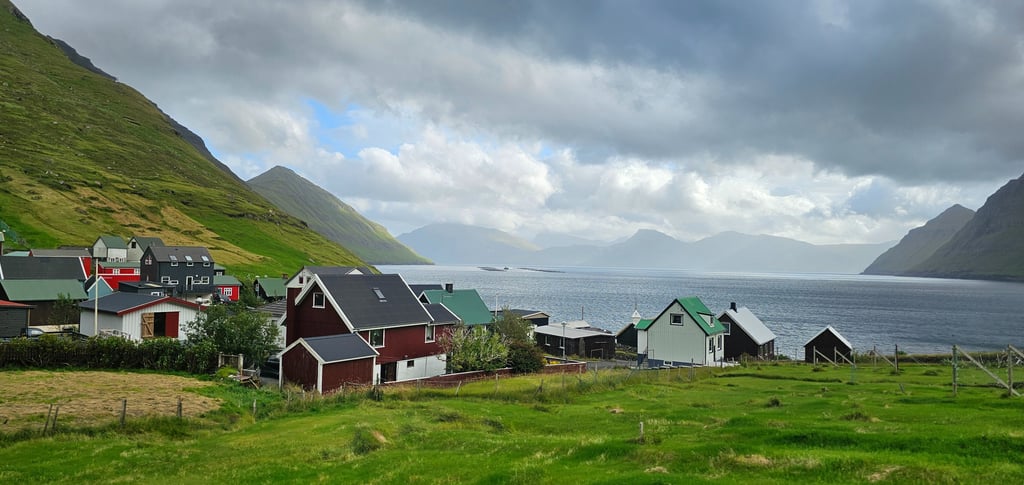

We landed at Vagar Airport at 8pm on 29th August 2025 after a smooth flight from Copenhagen, welcomed by the crisp and refreshing Faroese air as we stepped off the plane. Even before landing, the scenery had already captured our hearts. From the aircraft window, we were treated to a breathtaking view of Lake Sorvagsvatn, the cascading Bosdalafossur Waterfall, and the striking sea stacks of Tindholmur and Drangarnir as the plane descended. The lake appeared to float above the ocean, framed dramatically by towering cliffs and rugged mountains. It was a spectacular welcome to the Faroe Islands, a sight that instantly stirred our excitement for the adventure ahead.
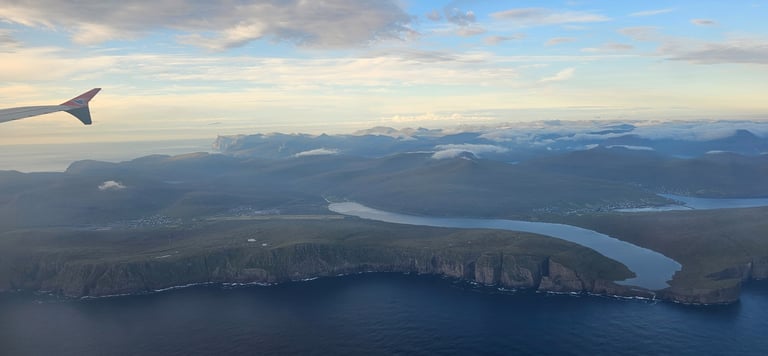

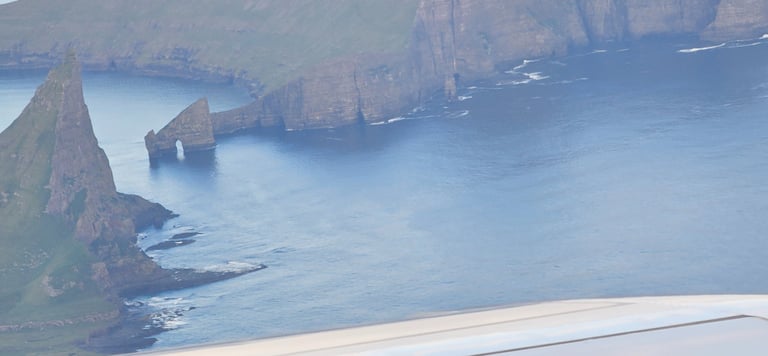

After picking up our rental car, we made our way through the remarkable Eysturoy Tunnel, the largest tunnel in the Faroe Islands and home to the world’s first undersea roundabout. Driving beneath the Atlantic with that unique circular roadway felt almost surreal, a true testament to human ingenuity set against nature’s grandeur.
Not long after, we arrived at our Airbnb in Selatrao, and it was every bit as enchanting as we had hoped. Tucked away amidst serene landscapes, the house exuded warmth and charm. It was spotless, cozy, and thoughtfully stocked with everything we could possibly need, from kitchen essentials to inviting interiors. Surrounded by such beauty, it instantly felt like a home away from home, a perfect retreat to rest, recharge, and prepare for the magical adventures awaiting us in the Faroe Islands.
Our first full day in the Faroe Islands began with a scenic drive from Selatrao to Vagar Island, crossing the Streymin Bridge. Along the way, we paused to admire the striking view of Tindholmur, one of the most photographed and iconic landmarks in the archipelago. Rising sharply from the sea at the mouth of Sorvagsfjordur, this uninhabited islet feels almost otherworldly. True to its name, which translates to “the islet with peaks,” Tindholmur is crowned with five jagged spires that pierce the sky like something from a fairytale. With cliffs, ocean, and sky framing it perfectly, it’s no wonder Tindholmur is considered one of the Faroe Islands’ most enchanting sights.
Standing right beside it is the legendary Drangarnir, the two dramatic sea stacks that guard the entrance to the fjord. The larger arch-shaped sea stack, known as Stori Drangur (the large sea stack), and the smaller one, Litli Drangur (the small sea stack), rise majestically from the Atlantic waters. Their rugged forms and natural stone arch create a scene that looks sculpted by the hands of giants. Together with Tindholmur in the backdrop, Drangarnir completes one of the most breathtaking and iconic vistas in the Faroe Islands.
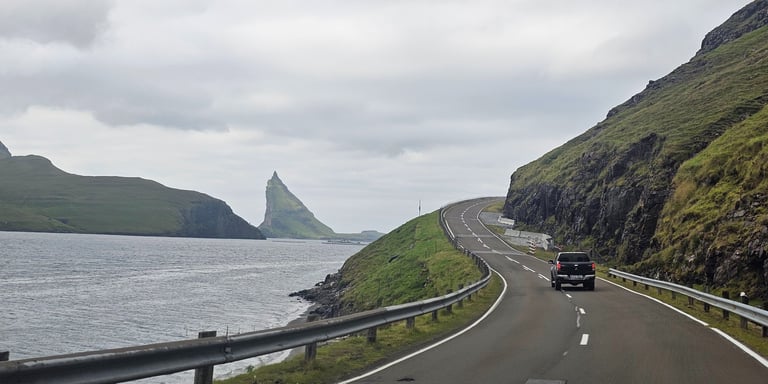

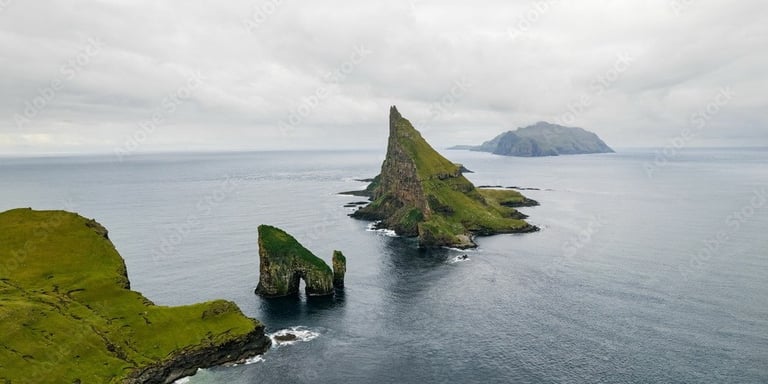

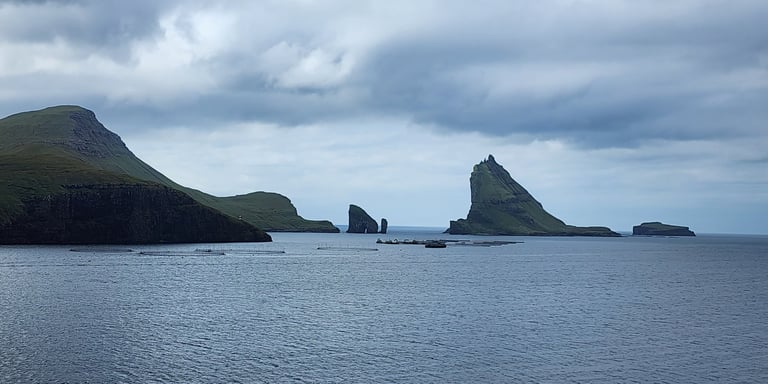


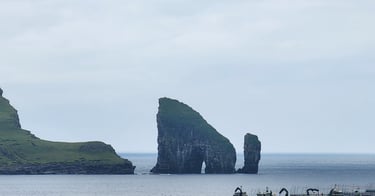
As we reached the charming village of Gasadalur, we set out on the short hike to the world-famous Mulafossur Waterfall. Perhaps the most iconic view of the Faroe Islands, this stunning waterfall plunges directly from a grassy cliff into the Atlantic Ocean, framed by steep mountains rising dramatically in the background. The trail begins just a few minutes from a small parking area, making it easy and accessible for almost everyone. Yet, within just ten minutes of walking, you suddenly find yourself immersed in untouched nature, standing before a scene that feels straight out of a storybook. From the main viewpoint, Mulafossur appears perfectly framed by the cliffs, a picture-postcard moment that captures the essence of the Faroe Islands.
Eager for a closer look, Ateeq and Zaid made their way down the steep concrete steps and carefully crossed the rocky terrain to view the waterfall from below. From that vantage point, the sight was even more powerful and awe-inspiring. They spent time there, soaking in the beauty of the scene and capturing countless photos to remember the moment.

We then continued to the quiet charm of Bour Village, where traditional turf roofed houses overlook the dramatic seascape of Tindholmur and the Drangarnir cliffs. The village felt almost timeless, its simplicity beautifully contrasted by the breathtaking natural backdrop. What struck us most was watching local children, some as young as 18 months, running and playing happily in just t-shirts and shorts, while we were bundled up in layers against the chill, a small but striking glimpse into the hardy Faroese way of life.
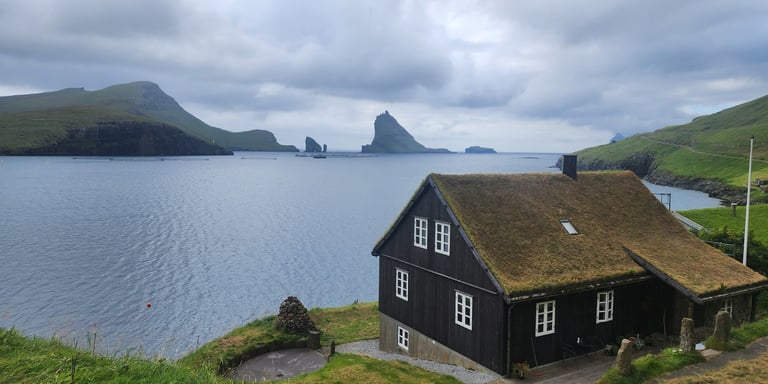

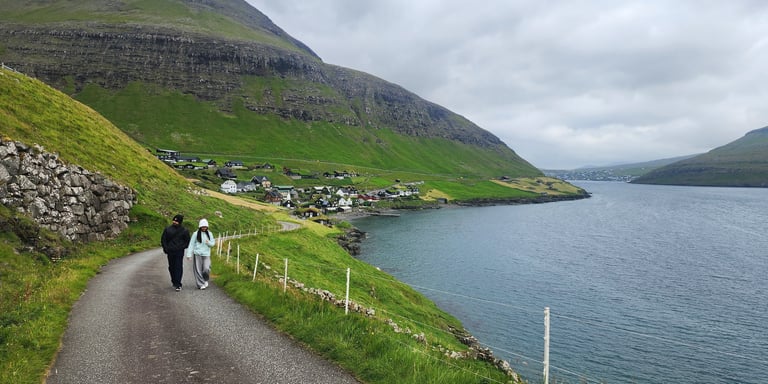

The day ended with a rewarding trek from Sandavagur to the viewpoint of Trollkonufingur, known as the Witch’s Finger. The 1.2 km trail, taking around 45 minutes, winds gently uphill from the village, gradually revealing ever-widening views over the Sorvagsfjordur fjord. The path, though steady, is well-marked and surrounded by grassy slopes and rocky outcrops, giving a true sense of Faroese wilderness. As we climbed higher, the air grew crisper and the landscape more dramatic, with the village and fjord stretching out behind us like a painted scene.
At the top, the Witch’s Finger finally revealed itself, a slender sea stack rising 313 meters from the ocean, standing tall and solitary like a giant finger pointing skyward. According to legend, it is the petrified finger of a troll woman, caught by the sun’s rays and turned to stone, a mystical tale that seems to suit the wild, dramatic landscape. Standing there, with seabirds circling and waves crashing below, we felt the raw and untamed spirit of the Faroe Islands all around us.
As the sun set, we drove back to Selatrao, where a warm dinner and a good night’s sleep awaited us, our hearts already full from a day of landscapes that felt like living myths.
The night before had brought heavy rain, followed by a morning wrapped in dense fog. After a sound sleep and a late breakfast, we left home hoping the weather would clear, but visibility was almost zero, at times we could not see beyond 15 - 20 meters. Driving carefully through the mist, we crossed the narrow rock-guarded causeway connecting Bordoy and Kunoy Islands before reaching the quiet village of Kunoy, where we spent a short while before heading back on to the Klakkur trailhead.
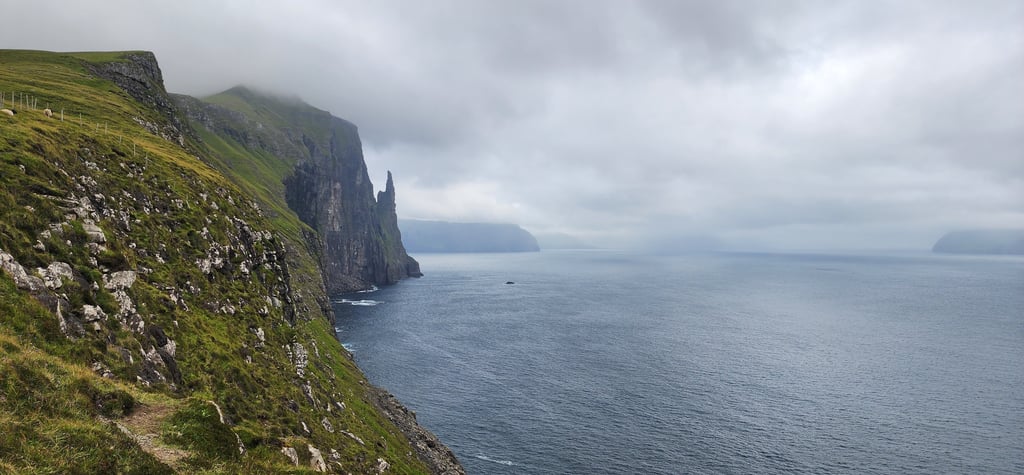


Our trek to Klakkur viewpoint was refreshing and tinged with mystery, as the weather added its own atmosphere to the experience. We parked the car at the gate, though cars could go further, we did not know about it so we walked the steep path on foot. Light drizzle accompanied us as we climbed, and the surrounding peaks disappeared into thick fog. Even Klaksvik, the second largest town in the Faroe Islands, was shrouded in mist, visible yet hazy, like a watercolor painting.
Tabasum and Zoya paused to take in the scene at the first view point viewing Klaksvik, while Ateeq and Zaid continued further up the trail to reach the top of Klakkur. The view there was breathtaking despite the fog. The sea stretched outward, framed by green slopes, while the great mountain south of Kalsoy rose above the ocean, its summit hidden in cloud, adding to the drama of the scenery. On our descent, the fog began to lift slightly, revealing Klaksvík in sharper detail. The colorful houses and winding streets stood out vividly, and the two football stadiums below were alive with matches, we could even hear the commentary echoing through the fjord. The lively sound, set against the misty calm, created a truly unique atmosphere.

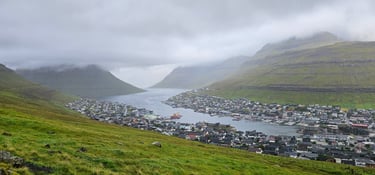
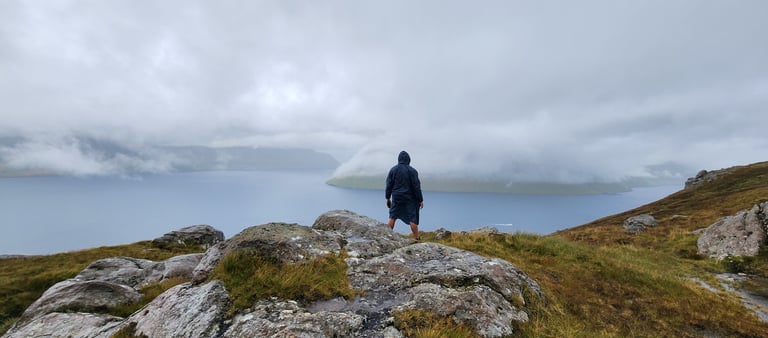

From Klaksvík, we took the ferry to Kalsoy Island, a short but scenic crossing. Driving the car straight onto the ferry made the journey easy, and while we stayed inside the car for most of the ride, we did step out to enjoy the sea views, with mountains rising steeply from the water around us.
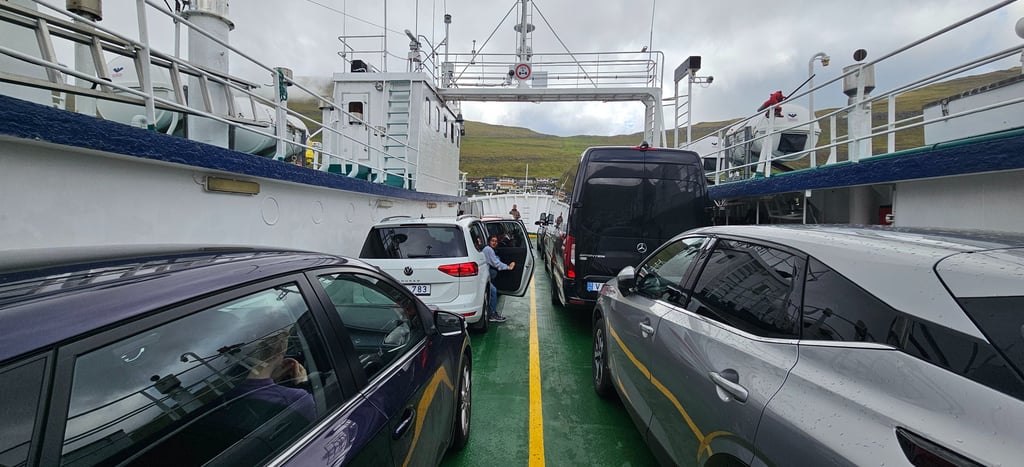

Once on Kalsoy, we drove north toward Trollanes and parked at the cafe where tickets for the Kallur Lighthouse trek are sold and set off on the trail. The hike was longer and steeper than expected, but the unfolding scenery made every step worthwhile. Behind us stretched the fjords and ocean, while ahead, green ridges rolled into the horizon. Sheep grazed lazily on the hillsides, a quintessential Faroese sight. The higher we climbed, the more dramatic the cliffs became, sheer drops plunging straight into the restless Atlantic.

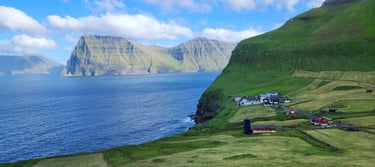
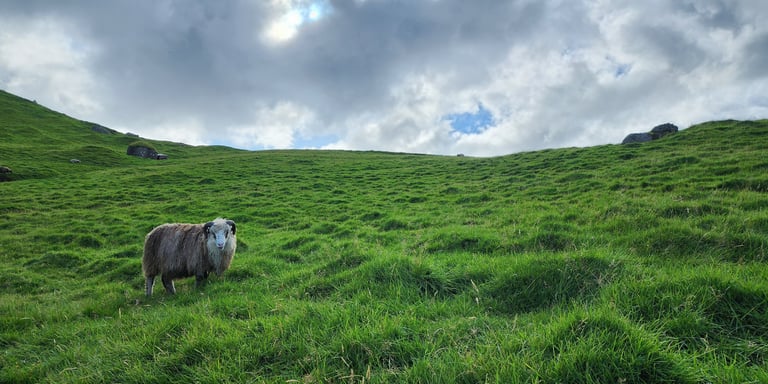

At last, we reached the Kallur Lighthouse, a small white structure perched proudly atop the grassy headland. The view here was unforgettable, ocean and sky colliding at the horizon, mountains looming from the sea, and the lighthouse itself standing as a sentinel against the vast Atlantic. Zoya lingered near the lighthouse, soaking in the panorama and capturing photos, while Ateeq and Zaid pushed further, climbing the last ridge. From that edge, the view was nothing short of iconic, the lighthouse in the foreground, and behind it, the towering bulk of Kalsoy’s cliffs, one of the most photographed images of the Faroe Islands. Standing there, with seabirds overhead and waves crashing far below, was both humbling and exhilarating.

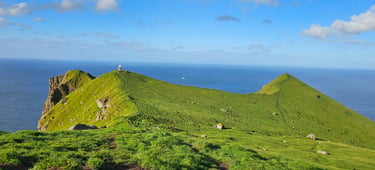

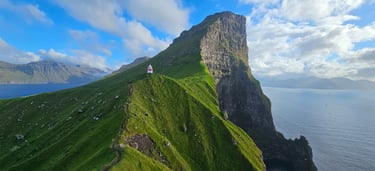
Before heading back, we visited the James Bond headstone, placed near the cliffs to mark the dramatic final scene of No Time to Die (2021), filmed at this very spot. It stands as a symbolic grave for Bond, adding a cinematic layer to the raw beauty of Kalsoy.
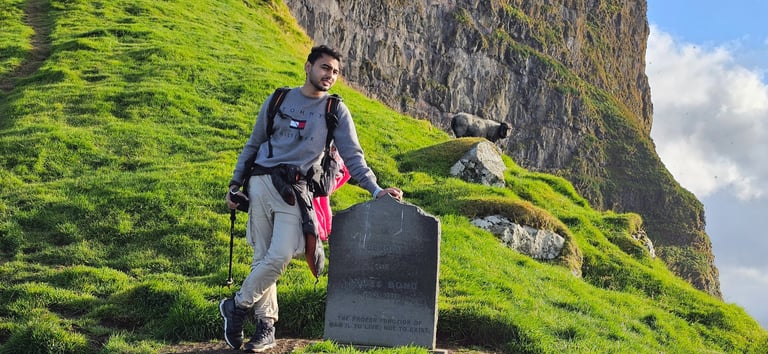

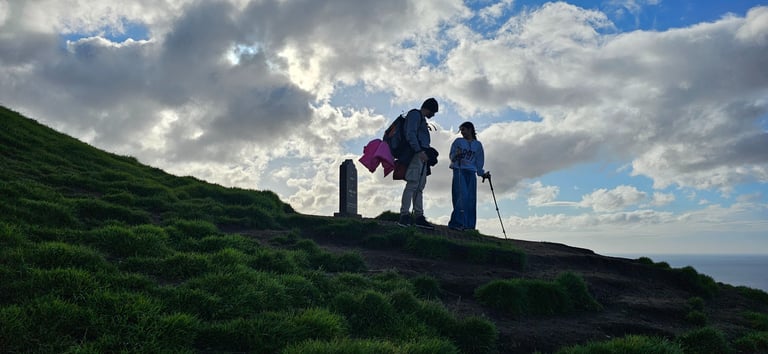

Though tiring, the return walk felt light, our hearts were full and our cameras full of memories. We had planned to stop at Mikladalur to see the Seal Woman statue but decided instead to return to the ferry and head back to Klaksvík. From there, we made our way home to Selatrao.

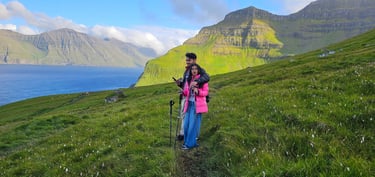
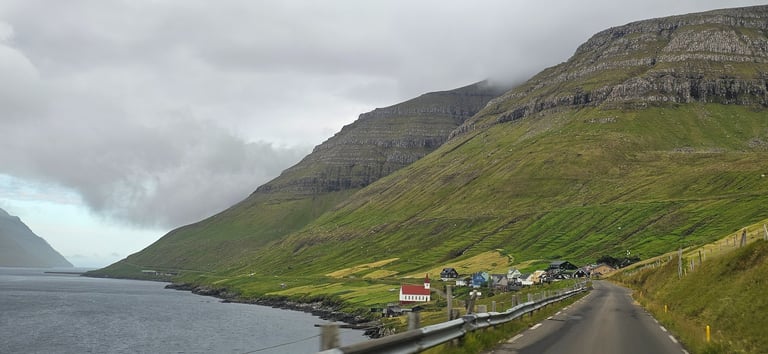

The day that began in fog ended with countless unforgettable moments. One thing we came to realize in the Faroe Islands is that the weather is truly unpredictable, the conditions on one island can be completely different from another, sometimes even within the same day. Yet whether shrouded in mist, drenched in drizzle, or lit by sudden sunshine, the islands revealed their beauty in every mood, leaving us with memories we will treasure forever.
The next day we drove to Funningsfjordur via Skalabotnur and paused briefly to take in the serene beauty of the fjord and its surroundings. From there, we continued our journey to Funningur, a picturesque village framed by towering mountains and the vast ocean beyond. We ventured down into the village to enjoy the view up close, before driving higher up the winding road where the scenery became truly spectacular. The sight from above was so mesmerizing that we stopped three times just to capture photos and videos of the landscape, it was impossible to resist.
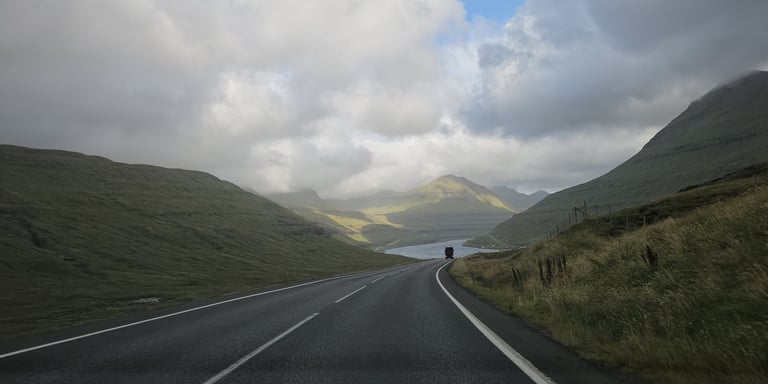

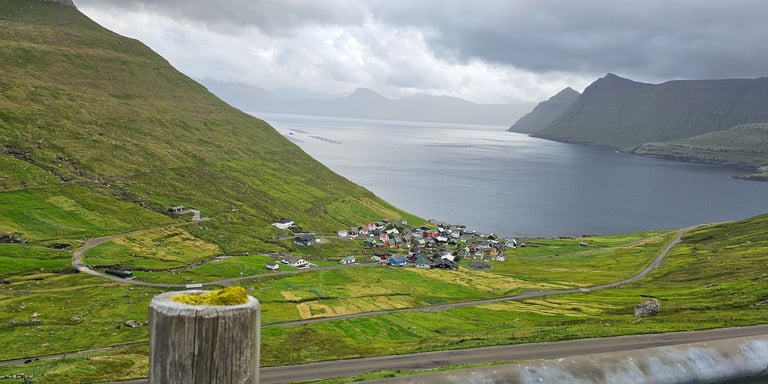

Our next stop was the enchanting village of Gjogv, renowned for its natural gorge that cuts dramatically into the sea. The gorge is a masterpiece of nature, carved over centuries by the relentless Atlantic waves. Standing above it, we were captivated by the narrow channel framed by steep, rugged cliffs, with the deep blue water rushing in and out in a rhythmic dance. The contrast between the lush green slopes surrounding the village and the jagged dark rocks made the view even more striking. We descended into the gorge via the stone stairs, bringing us closer to the water. From below, the scene was even more magical, the gorge felt like a secret doorway to the ocean, echoing with the sound of waves. We took plenty of photos, capturing the raw beauty of the cliffs and the deep channel where fishing boats once sought shelter.

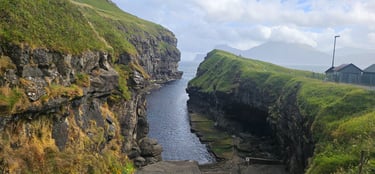
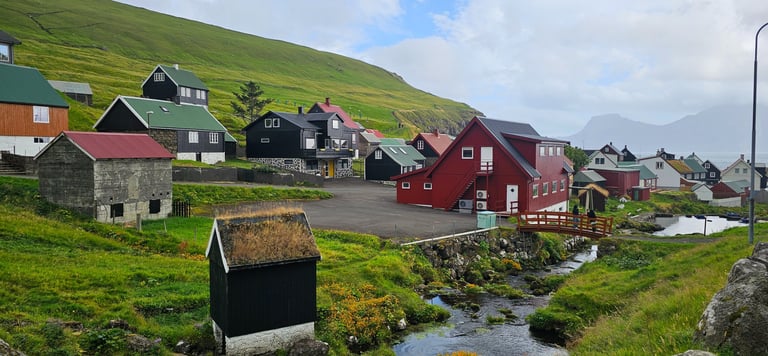

Afterwards, we explored nearby viewpoints overlooking the ocean. The scenery stretched endlessly, seabirds soaring above, dramatic peaks lining the coastline, and the Atlantic horizon melting into the sky. It was like standing inside a painting, with every detail perfectly placed.
We then stopped at Lake Eidi, a tranquil expanse surrounded by rolling green hills and scattered rocks. Its glassy surface reflected the sky and mountains like a natural mirror. We lingered for photos, soaking in the peaceful stillness before continuing our journey.
Soon, we arrived at the viewpoint of Risin og Kellingin (“The Giant and the Witch”), the legendary sea stacks rising dramatically from the Atlantic. The cliffs, the crashing waves, and the myth-steeped formations together created a scene both powerful and enchanting. According to folklore, the giant and witch tried to drag the Faroe Islands back to Iceland, but sunlight turned them to stone. The formations, almost human like, seemed to bring the tale to life. With the binoculars placed at the viewpoint, we studied Kellingin more closely, its silhouette resembling a figure standing against the sea.
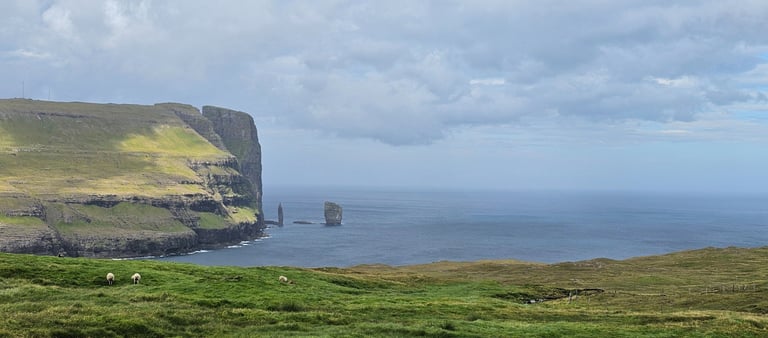


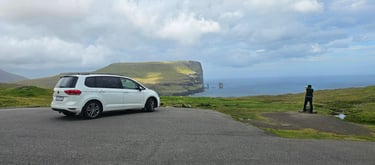
From there, we continued to Fossá, the tallest waterfall in the Faroe Islands. Cascading down steep cliffs, the waterfall roared with immense power. Zaid and Ateeq hiked closer for a better view, where the wind shifted the water sideways, creating a dramatic spectacle. The spray painted the air with mist and rainbows, making the moment unforgettable. Fossa felt alive - constantly changing, never still, each gust of wind reshaping its flow.
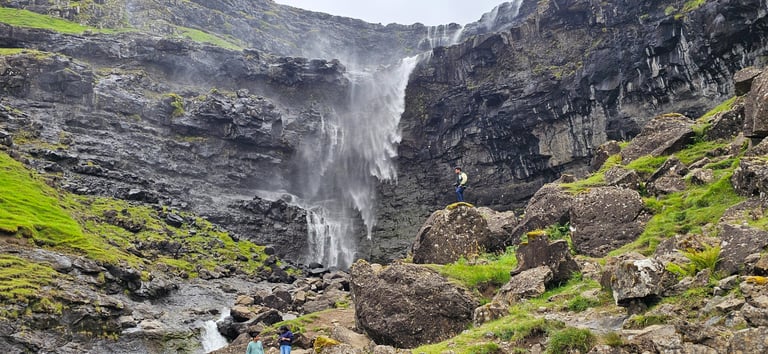

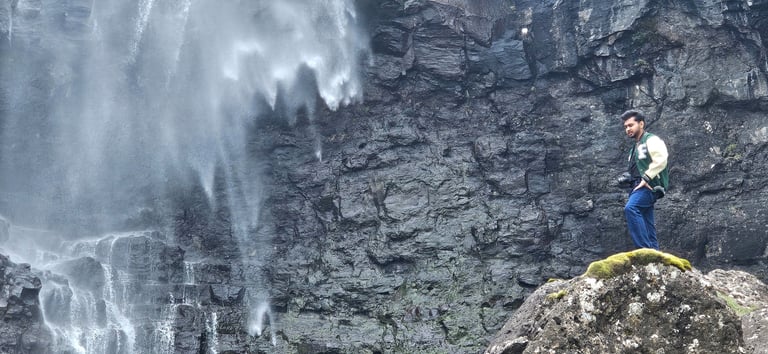

Our journey then led us to the black-sand beach at Tjornuvík, a village nestled serenely between sea and mountains. Its peaceful streets were pristine and quiet, adding to its charm. While Tabasum and Zoya prepared lunch, Ateeq and Zaid trekked up the nearby mountain for a panoramic view of the village. From the top, the sight was absolutely breathtaking. The village resting against the backdrop of the mountains, the dark sands stretching to meet the gentle waves of the sea, and the vast horizon beyond with Risin og Kellingin rising at the end. It was, without a doubt, the most spectacular view we had experienced in the Faroe Islands. The harmony of village calmness, mountain grandeur, and ocean vastness, crowned with the legendary sea stacks, was a scene etched forever in our memory.
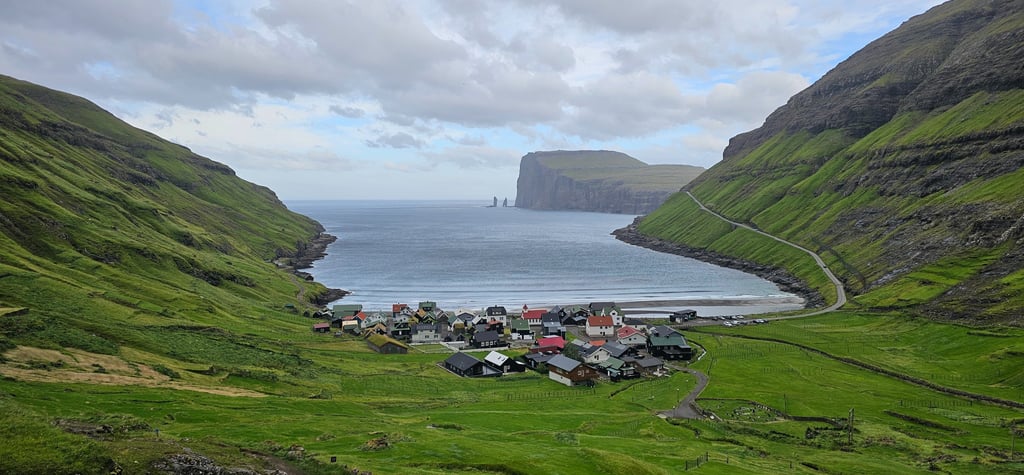

Later in the evening, we visited the capital, Torshavn, strolling through its quaint streets before ending at the Art Museum. The museum offered a fascinating glimpse into Faroese history, culture, and artistic heritage, adding a new layer of meaning to our travels.
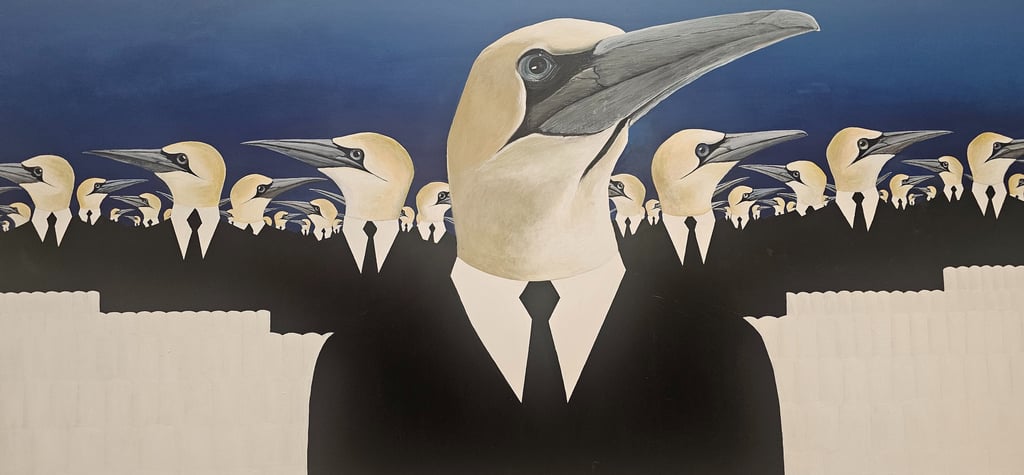

Finally, we returned to Selatrao for a hearty dinner and well-deserved rest. It was another day filled with majestic landscapes, charming villages, and unforgettable family moments.
The next day, after a late breakfast, we checked out of our Selatrao Airbnb and made our way to Miovagur for one last adventure in the Faroe Islands before our flight to Iceland. Our destination was the trail to Traelanipan (Slave Rock) and the spectacular Bosdalafossur Waterfall, where the famous Lake Sorvagsvatn creates the illusion of “hanging” above the ocean.

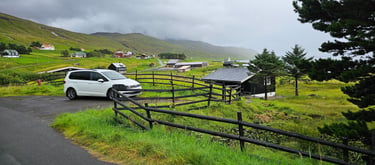
The hike itself was an experience to remember. The trail wound through rolling green hills, rugged cliffs, and pockets of wildflowers, offering glimpses of the Atlantic and the surrounding mountains as we climbed higher. The air grew cooler and fresher with each step, and the anticipation of seeing the iconic hanging lake view kept us energized. The path, though moderately challenging with a few steep sections, rewarded us with scenery at every turn.

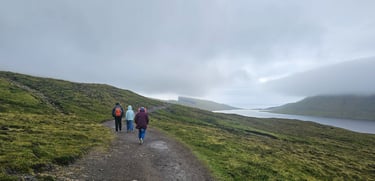
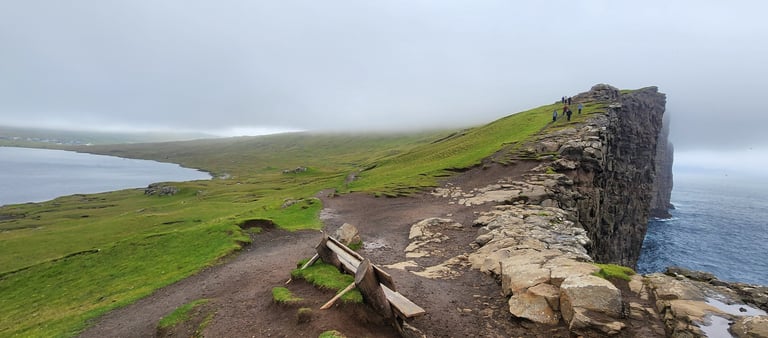

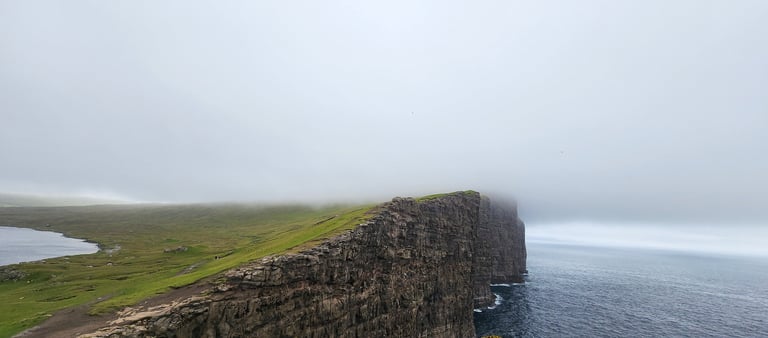

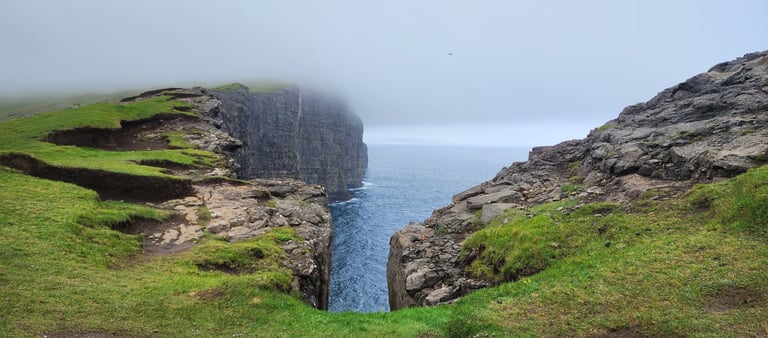

By the time we reached the summit, however, a thin veil of fog had drifted in, hiding the dramatic panorama we had been waiting for. We lingered nearly 40 minutes in hope the mist would clear, but the lake’s famous “hanging” illusion never revealed itself. Still, nature had its own way of making up for it. One can see below how the lake looks like on a clear day and what we experienced.
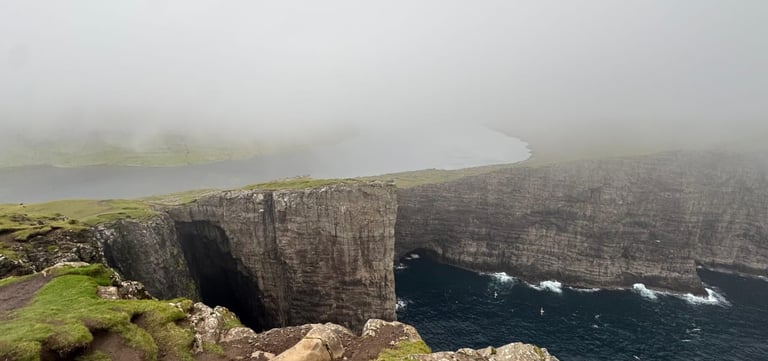


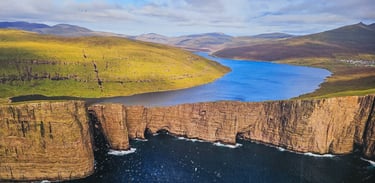
On the descent toward the waterfall, the landscape opened up with crystal-clear views. The Bosdalafossur Waterfall thundered before us, tumbling into the ocean with mountains framing the scene on either side. From that vantage point, we could see everything at once, the lake, the cliffs (summits covered by fog), the waterfall, and the endless Atlantic merging into the horizon. It was breathtaking, and we spent a long while there capturing photos, absorbing the sights, and simply appreciating the raw beauty surrounding us.
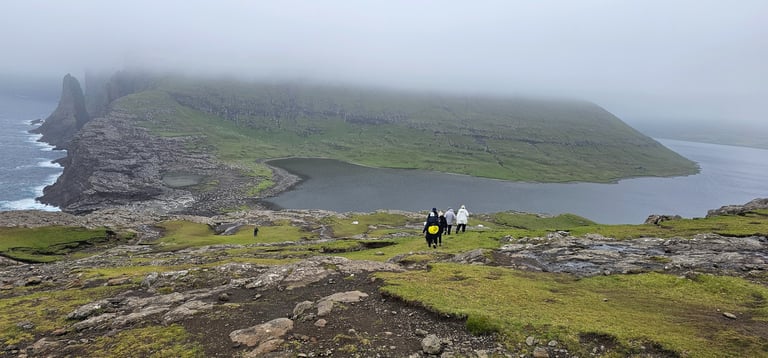

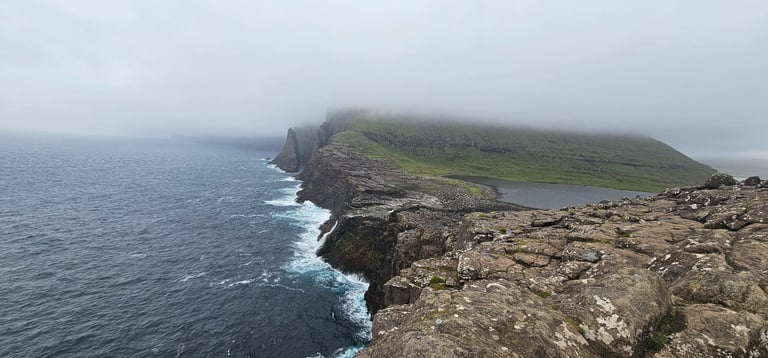

Although we missed the iconic view from above, the hike was still deeply rewarding. Between the cliffs, waterfalls, fjords, and charming villages, the Faroe Islands had already far exceeded our expectations.
After finishing the trek, we drove back to Sorvagur, to check-in the camper we had booked for the night, ready for our early morning flight to Iceland. Later we returned back the rental car at airport and walked back to the camper. On the way, we were treated to a surprise, watching a plane land at Vagar from very close, a thrilling sight we quickly recorded on our phones. From the hillside, we could also admire Sorvagur itself, nestled around a fjord with views that seemed to stretch forever.

As we settled into the camper that evening, we reflected on a days we spent in Faroe Islands, it was nothing short of magic. From dramatic cliffs and misty fjords to quaint villages and legendary sea stacks, every moment felt like stepping into a living fairytale. The mix of raw natural beauty and timeless folklore made the islands unlike anywhere else we have ever been. What began as a family adventure quickly became a journey of wonder, discovery, and connection with nature, with stories of the past, and with each other. As we left the Faroes behind, we carried with us not only photographs and memories but also a deep sense of awe for this remote archipelago at the edge of the world.
Contact
v4@exploreonyourown.com
